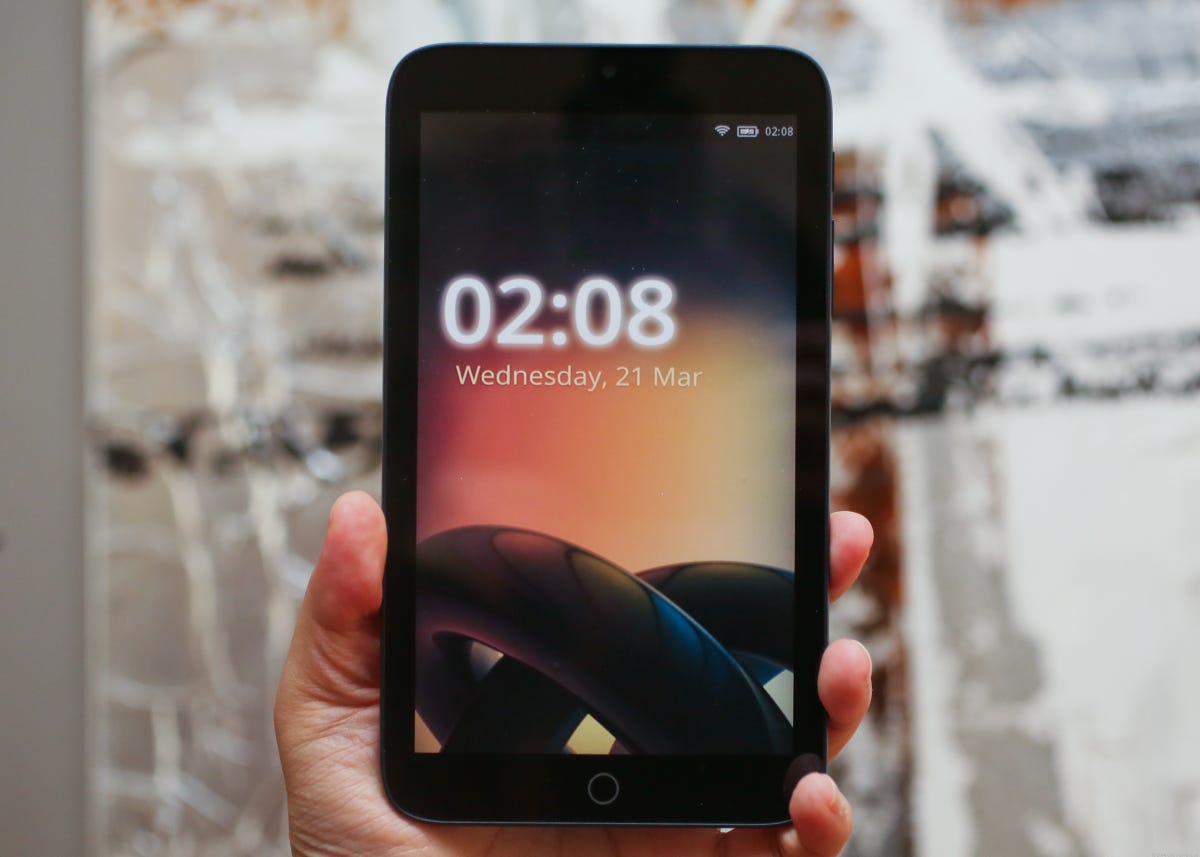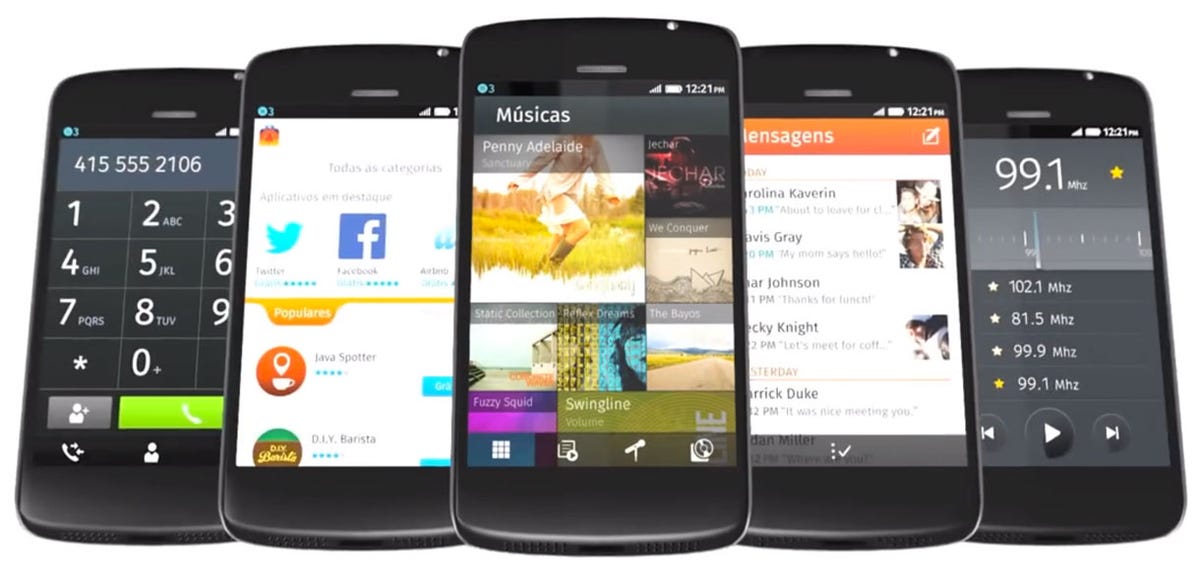BARCELONA — Mozilla doubled down on its bet that low-end smartphones will give Firefox OS a place in the crowded mobile market, announcing partnerships Sunday that will bring $25 smartphones to the large number of people who can’t afford high-end models like Apple’s iPhone 5S and Samsung’s Galaxy S5 that cost hundreds of dollars.
At the Mobile World Congress here, Mozilla announced a deal with Chinese chip designer Spreadtrum Communications that will mean Firefox OS smartphones will arrive in extremely cost-sensitive markets like India and Indonesia where people often buy phones from a bin in a store.
“We’re working with them to break through the $50 barrier, which is hard,” Mozilla Chief Technology Officer Brendan Eich told CNET. “This is going to be for a set of [sales] channels in Asia that do not involve operators,” the carriers that in other parts of the world dominate distribution.
One company that plans to make and promote the phones is Indonesia-based Polytron. And Indonesian carriers Telkomsel and Indosat plan to sell the devices.
Hands-on testing shows the cheap Firefox OS phones to be workable. “This is a price point currently out of the reach of Google and even the lowest-cost Android handset vendors. It pushes Firefox OS into feature-phone territory, potentially signaling the beginning of the end for the category,” said Ovum analyst Nick Dillon in a statement.
The phones may seem small, underpowered, and short on features to people used to modern Android and iOS phones. But Mitchell Baker, chair of the Mozilla Foundation, said at a press conference here that the devices have to be judged by a different, lower-end standard.
“Imagine the phone in your pocket is a feature phone. Imagine, when you go buy one of these devices, that every euro is precious to you,” Baker said. Looking at “the richness and power we’re able to offer to this market, you’ll be astonished. Then imagine where we can go from there.”
Mozilla has found a small niche in the mobile OS market by pursuing its low-end strategy, with the first phones debuting in countries such as Hungary, Venezuela, Colombia, Brazil, and Greece. Mozilla, a non-profit organization, hopes to use the browser-based operating system to lower the barriers that today keep people locked into ecosystems linking hardware, OS, app store, services, content, and apps.
Mozilla also expanded partnerships with the Firefox OS allies it announced last year at the same show, Alcatel and ZTE. They debuted upgraded models that move to dual-core processors and add larger-screen options, bringing a little more processing horsepower to Firefox OS without raising the price.
One of those Alcatel phones, the One Touch Fire S, pushes Firefox OS to new heights a quad-core processor and support for faster new 4G LTE networks. And Alcatel also showed off an early version of a planned new tablet, the One Touch Fire 7.


CNET
Also at Mozilla’s event, a new partner, Huawei, showed off its first Firefox OS phone. The Y300 comes with a 4-inch 800×480 screen, dual-core processor, 512MB RAM, a 5-megapixel rear-facing camera, a 0.3-megapixel front-facing camera, and Firefox OS 1.1. It’s not clear yet when that model will go on sale.
LG Electronics introduced a Firefox OS later phone last year, the Fireweb, and didn’t have any updates. Sony last year said it planned a Firefox OS phone for 2014, but it didn’t have any on display.
Firefox OS takes on challenges
Today, Apple’s iOS and Google’s Android dominate the market for smartphones and tablets. Challengers like Microsoft’s Windows Phone, Ubuntu Touch, WebOS, BlackBerry OS, and Samsung’s Tizen have struggled to push these aside: it’s hard to compete against an incumbent that’s got millions of users, hundreds of thousands of apps, and few signs of the complacency that can open a door for challengers.
Related stories
- iPad Pro 2020 reviews, YouTube to throttle video quality
- Mozilla helps modernize feature phones powered by Firefox tech
- Mozilla may start offering premium services this fall
- Sticker shock over Apple’s $1,000 stand, Firefox blocking cookies
- Mozilla three years later: Is Firefox in a better place?
Firefox OS won’t have an easy time of it. There’s not as much money to be squeezed from low-end markets, so developers aren’t as likely to pursue it as avidly. The Spreadtrum chipset will support only 2.5G Edge mobile networks that, while common in poorer parts of the world, are too slow for a lot of modern apps. And Google is pushing toward lower-end phones, with Android 4.4 memory-saving techniques that fit KitKat into phones with 512MB of RAM.
At the same time, though, Firefox is pushing, too. It uses the same ZRAM memory compression technique to halve its memory requirement to 128MB of memory, Eich said.
Getting down to $25 phones means Firefox OS will provide an alternative for people who’d otherwise buy a feature phone — a model with a few built-in apps but not much more.
So Firefox has a chance there. But in the long run, to succeed, Firefox OS will need to push up-market, and it’s not clear how Mozilla will succeed there with much stronger competition.
Huawei takes the Firefox OS plunge with the Y300 (pictures)






Dual-core Firefox OS phones
Phone makers are helping to push Firefox OS toward higher-end models. The first-generation Firefox OS phones like the Alcatel One Touch Fire had single-core Qualcomm processors.
Now that’s changing with a host of new models that should arrive at the same low prices. Arriving at the show are two ZTE phones and four Alcatel phones:
- The ZTE Open C has a 4-inch, 800×480 display, a dual-core 1.2GHz Qualcomm Snapdragon 200 processor, 3G networking; 1,400mAh battery, 512MB RAM, 2GB flash storage, and 3-megapixel camera. The Spanish carrier Telefonica will sell it in Venezuela and Uruguay in the second quarter of 2014, ZTE said.
- The ZTE Open II has a 3.5-inch 480×320 display, dual-core 1.2GHz Qualcomm Snapdragon processor, 3G networking; 1,150mAh battery, 256MB RAM, 2GB flash storage, and 2-megapixel camera. Telefonica will sell this model in six countries
- The Alcatel One Touch Fire S, the company’s highest-end model, has 4G LTE networking, a 4.5-inch 960×540 IPS screen, a quad-core 1.2GHz processor, an 8-megapixel rear-facing camera and 2-megapixel front-facing camera, and support for near-field communications (NFC).
- The Alcatel One Touch Fire E is a step down. It’s also got a4.5-inch 960×540 screen, but not with in-plane switching, and its 1.2GHz processor is only a dual-core model. Its rear-facing camera has a 5MP resolution but its front-facing camera is only 0.3MP.
- The Alcatel One Touch Fire C is the clear successor to 2013’s model. Its 3.5-inch 480×320 screen is the same size, but it now is accompanied by a dual-core 1.2GHz processor. Its camera is pretty low-end, just a 0.3-megapixel model.
Tablets and more
Alcatel is also the first to push a Firefox OS tablet, the One Touch Fire 7, into the market. Electronics companies Foxconn and Via have worked on reference designs, but Alcatel is aimmig the Fire 7 at the mass market.
It’s got a 7-inch 960×540 display, dual-core 1.2GHz processor, 0.3-megapixel front and rear cameras, a 9.9mm thickness, and 285g weight. With those specs, it looks like Alcatel plans reproduce the low-budget Firefox OS phone strategy but this time with tablets.


Telefonica Brazil screenshot by Stephen Shankland/CNET
Mozilla itself will be selling phones, too: a reference design called the for hardware and software partners called the Firefox OS Flame.
It’s got a Qualcomm 1.2GHz dual-core Snapdragon processor, a 4.5-inch 854×480 screen, a 5MP rear-facing camera and 2MP front-facing camera, 3G networking, 8GB of flash storage, NFC, a 1,800mAh battery. Unusually, it’s got RAM that can be adjusted between 256MB and 1GB so developers can test different configurations.
Mozilla’s main focus is on smartphones, but it’s encouraging others to help push Firefox OS into tablets. Via’s 7-inch Vixen 7 and Foxconn’s 10-inch InFocus are available to developers who are interested in the area.
The Firefox OS ecosystem is clearly maturing. It’s nowhere near the scale of Android or iOS, but the first-stage partnerships announced a year ago are deepening and broadening.



